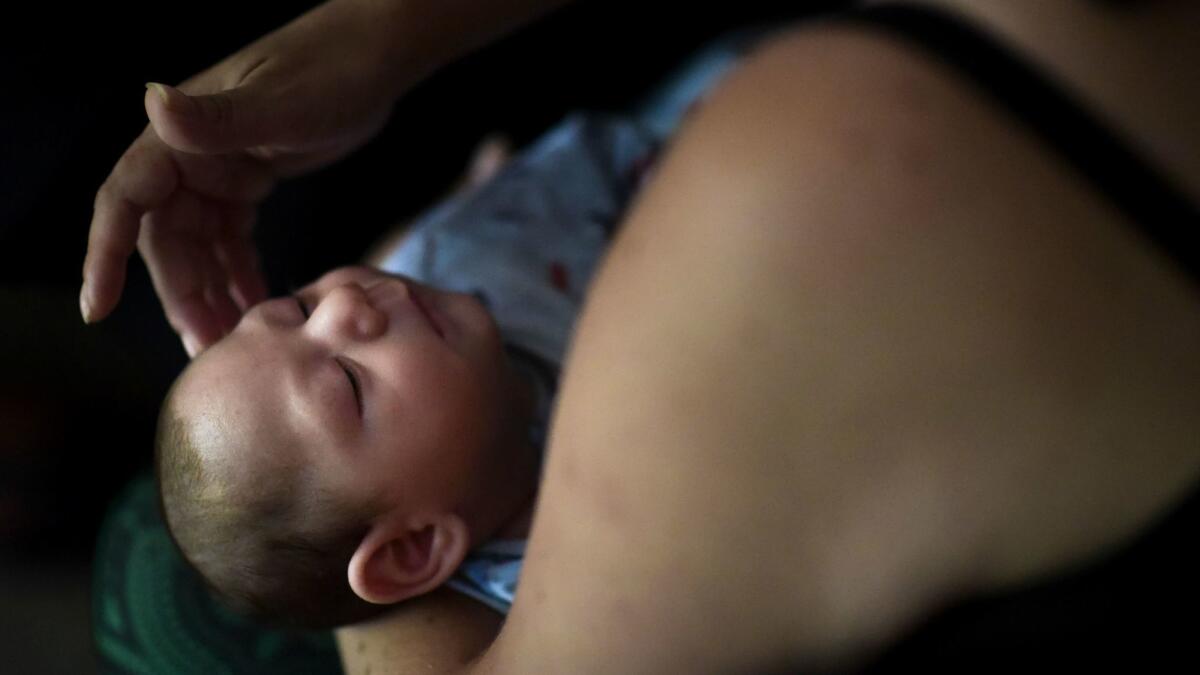Microcephaly or other birth defects seen in 5% of pregnancies affected by Zika, CDC says

- Share via
About 1 in 20 women who became infected with Zika during their pregnancies had a baby with microcephaly or other birth defects that were probably caused by the virus, according to a new report from the
That figure is based on an analysis of 2,549 pregnancies in U.S. territories where Zika was spreading from person to person by Jan. 1, 2016. It’s in line with a previous report from the 50 states involving pregnant women who became infected while traveling abroad in places where the virus was circulating, but it’s considered more accurate because it comes from a more complete set of data.
Beginning in February 2016, the CDC recommended that all pregnant women living in places with local Zika transmission be tested for the virus, even if they showed no signs of infection. Those who had negative test results in their first trimester were retested in the second and third trimesters, just to be sure no cases slipped past health officials.
In the U.S. territories of American Samoa, Puerto Rico and the U.S. Virgin Islands, plus the Federated States of Micronesia and the Marshall Islands, the surveillance efforts turned up 2,549 cases of women who were thought to be infected with Zika and who completed their pregnancies between Jan. 1, 2016 and April 25, 2017. Here’s what happened to them:
- Among the women, 61% had outward signs of Zika infection and 38% were asymptomatic throughout their pregnancies. (Data was unavailable for 1% of the women.)
- The vast majority — 97% — of their pregnancies ended with a live birth. The remaining 3% resulted in a miscarriage.
- Overall, 122 of the pregnancies — 5% — ended with a fetus or baby with a birth defect associated with Zika infection. These included microcephaly, brain or eye abnormalities, neural tube defects or other problems with the central nervous system.
- Among women who had outward symptoms of Zika infection, 5% had a fetus or baby with a birth defect. For women without symptoms, the figure was 4%.
- The brain was the most common organ to be affected by Zika. Of the 122 fetuses and babies with a birth defect, 89% had microcephaly or another brain abnormality.
- Among the 2,508 cases where the timing of Zika infection was known, 21% occurred during the first trimester, 44% were in the second trimester and 35% were in the third trimester.
- The risk of a birth defect varied a bit based on the timing of infection. When infection occurred in the first trimester, 6% of the pregnancies experienced a birth defect. When the infection was in the second trimester, 5% of pregnancies resulted in a birth defect, and in the third trimeter, 4% of pregnancies were affected.
- Of the 2,549 cases, 1,508 — or 59% — of the women had their infections confirmed through a laboratory test that detected viral RNA. In this subgroup, birth defects occurred in 5% of the pregnancies of women who had symptoms of Zika infection and in 7% of women who remained asymptomatic.
- As with the overall group, birth defects in this subgroup were most likely to occur when the mother was infected during the first trimester (8%), followed by the second trimester (5%) and third trimester (4%).
In this study, the greatest risk was seen in cases where the woman was infected during the first trimester of her pregnancy, and that infection was confirmed with a laboratory test. Among these women, 8% had a fetus or baby with a birth defect. The comparable rate for women from the 50 states was 15%, according to previous research. However, the authors of the new study noted that the number of birth defects was too small for them to be sure that the difference was real and not just a statistical fluke.
The results were published Thursday in the CDC’s Morbidity and Mortality Weekly Report.
Follow me on Twitter @LATkarenkaplan and "like" Los Angeles Times Science & Health on Facebook.
MORE IN SCIENCE
These 12 Americans had the right stuff to be picked for NASA's new class of astronaut trainees
Scientists defy Einstein's prediction and use relativity to measure a star's mass
Earliest fossil evidence of Homo sapiens found in Morocco, rewriting the story of our species




